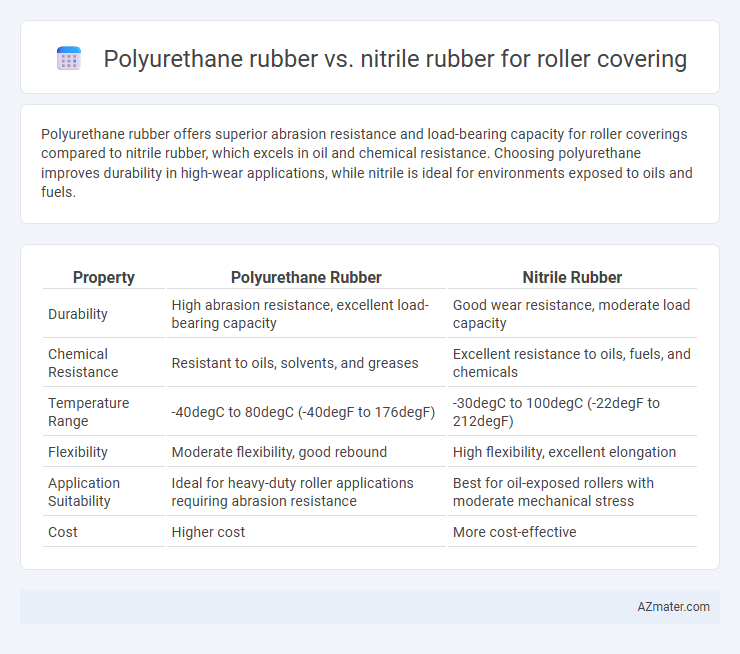Polyurethane rubber offers superior abrasion resistance and load-bearing capacity for roller coverings compared to nitrile rubber, which excels in oil and chemical resistance. Choosing polyurethane improves durability in high-wear applications, while nitrile is ideal for environments exposed to oils and fuels.
Table of Comparison
| Property | Polyurethane Rubber | Nitrile Rubber |
|---|---|---|
| Durability | High abrasion resistance, excellent load-bearing capacity | Good wear resistance, moderate load capacity |
| Chemical Resistance | Resistant to oils, solvents, and greases | Excellent resistance to oils, fuels, and chemicals |
| Temperature Range | -40degC to 80degC (-40degF to 176degF) | -30degC to 100degC (-22degF to 212degF) |
| Flexibility | Moderate flexibility, good rebound | High flexibility, excellent elongation |
| Application Suitability | Ideal for heavy-duty roller applications requiring abrasion resistance | Best for oil-exposed rollers with moderate mechanical stress |
| Cost | Higher cost | More cost-effective |
Introduction to Roller Covering Materials
Polyurethane rubber offers exceptional abrasion resistance and high load-bearing capacity, making it ideal for roller covering in heavy-duty industrial applications. Nitrile rubber provides excellent oil and chemical resistance, ensuring durability in environments exposed to greases and solvents. Choosing between polyurethane and nitrile roller coverings depends on specific operational demands such as wear resistance, chemical exposure, and mechanical stress.
Overview of Polyurethane Rubber
Polyurethane rubber offers exceptional abrasion resistance and high load-bearing capacity, making it ideal for roller covering in heavy-duty industrial applications. Its superior elasticity and excellent resistance to oils, solvents, and chemicals provide enhanced durability compared to nitrile rubber, which typically has good oil resistance but lower wear resistance. Polyurethane's ability to maintain performance under extreme mechanical stress ensures longer roller lifespan and improved operational efficiency.
Overview of Nitrile Rubber
Nitrile rubber, known for its excellent oil and chemical resistance, is widely used in roller covering applications where exposure to fuels, oils, and greases is common. Its high abrasion resistance and durability make it suitable for industries such as printing, automotive, and manufacturing, providing reliable performance under mechanical stress. Compared to polyurethane rubber, nitrile offers superior resistance to petroleum-based fluids but generally has lower resilience and elasticity.
Key Properties of Polyurethane Rubber
Polyurethane rubber offers exceptional abrasion resistance, high elasticity, and superior load-bearing capacity, making it ideal for roller covering applications that require durability and performance under heavy mechanical stress. Its excellent resistance to oil, grease, and solvents surpasses that of nitrile rubber, providing enhanced longevity in industrial environments with exposure to harsh chemicals. The material's ability to maintain dimensional stability and withstand repeated compressive forces ensures consistent roller performance and reduced maintenance costs compared to nitrile rubber options.
Key Properties of Nitrile Rubber
Nitrile rubber (NBR) offers excellent oil and chemical resistance, making it ideal for roller coverings exposed to lubricants and fuels. Its high abrasion and tear resistance ensures durability during continuous mechanical stress and friction. The material's good compression set and temperature range from -40degC to 120degC support varied industrial roller applications.
Polyurethane Rubber vs Nitrile Rubber: Durability Comparison
Polyurethane rubber offers superior abrasion resistance and tensile strength compared to nitrile rubber, making it highly durable for roller coverings subjected to heavy wear. Nitrile rubber excels in oil and chemical resistance but generally exhibits lower tensile strength and faster wear under mechanical stress. For applications demanding extended service life and high durability, polyurethane rubber is the preferred choice over nitrile rubber.
Chemical Resistance: Polyurethane vs Nitrile Rubber
Polyurethane rubber offers exceptional resistance to abrasion, oils, and solvents, making it ideal for roller coverings in harsh chemical environments. Nitrile rubber excels in resisting fuels, lubricants, and many acids, providing reliable protection where hydrocarbon exposure is frequent. Choosing between polyurethane and nitrile depends on the specific chemical agents involved and the operating conditions of the roller application.
Cost Analysis: Polyurethane vs Nitrile for Rollers
Polyurethane rubber offers higher durability and resistance to abrasion compared to nitrile rubber, leading to longer service life and reduced replacement frequency for roller coverings. Nitrile rubber generally has a lower upfront cost but may incur higher maintenance and downtime expenses due to faster wear rates in high-friction applications. When analyzing total cost of ownership, polyurethane often proves more cost-effective for demanding roller environments despite its initially higher price point.
Applications: Best Use Cases for Each Material
Polyurethane rubber excels in roller covering for applications requiring high abrasion resistance, load-bearing capacity, and smooth surface finish, making it ideal in printing, textile, and industrial conveyor systems. Nitrile rubber is preferred for roller covers in environments exposed to oils, fuels, and chemicals due to its superior oil resistance and good tensile strength, commonly used in automotive and food processing industries. Selecting between polyurethane and nitrile depends on specific operational conditions such as chemical exposure, wear demands, and mechanical stress requirements for optimized roller performance.
Choosing the Right Roller Covering for Your Industry
Polyurethane rubber offers exceptional abrasion resistance and flexibility, making it ideal for heavy-duty roller coverings in industries such as printing, packaging, and metalworking. Nitrile rubber excels in oil and chemical resistance, suitable for applications in automotive, food processing, and chemical industries where exposure to solvents and greases is common. Selecting the right roller covering depends on specific operational demands, including wear resistance, chemical exposure, and temperature tolerance, ensuring optimal performance and longevity in industrial environments.

Infographic: Polyurethane rubber vs Nitrile rubber for Roller covering
 azmater.com
azmater.com